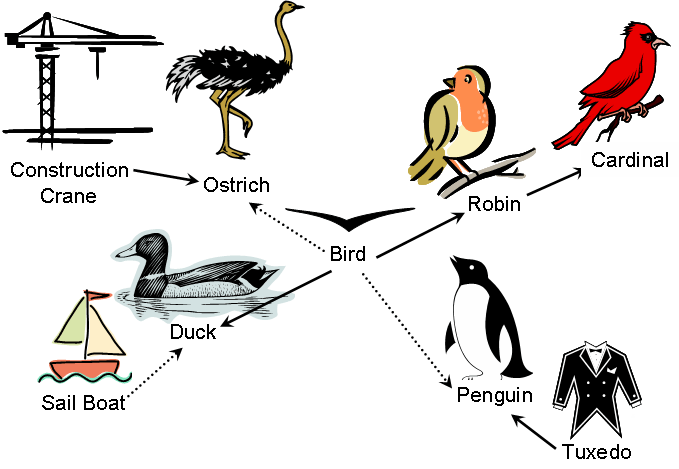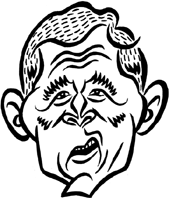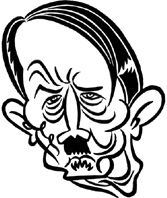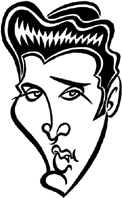Think of a bird and allow a bird image to form in your mind. Now envision a robin, and now a cardinal, and now a blue jay. Your mind begins with an image of a typical bird, then adjusts that image to add the specific characteristics of each particular species as they are named. You are relying on mental symbols to organize and extend your memory.
Definitions
- Mental prototypes for organizing and extending memories.
- Icons.
- An arbitrary sign that has acquired a significance.
- A group identifier.
- Categories.
The Greek root words mean “to throw together”; so a symbol is a mechanism for creating categories and identifying a group.
Related Terms
Approximate synonyms for graphic representation of a symbol include: badge, design, emblem, figure, icon, image, label, logo, representation, sign, and token. But the particular meaning we are describing here is an extensible mental representation, not a graphic image. Label is a close synonym. Categories are the partitioning represented by the symbol.
Icons
 Icons are simple enduring visual representations capturing the essential characteristics of a class of objects. They are simple and very general symbols, as these examples illustrate. Icons are simple enduring visual representations capturing the essential characteristics of a class of objects. They are simple and very general symbols, as these examples illustrate.
Icons are often at the root of mental schema created for organizing and classifying symbols. For example a bird icon may be at the center of a network of symbols each representing a particular bird species. The bird icon may link to an animal icon and icons for airplanes, feathers, eggs, and nests.
Select and Extend
All language is made up of symbols. The word “bird”, whether spoken, illustrated, signed, thought, or written, is not a bird, but is a symbol for a bird. If you are asked to envision a bird, you will probably either call to mind the image of an average, typical, or generic bird or a simple image of a specific but common bird species. This is your mental “bird symbol” — the basic mental representation you hold of a bird. The symbol for a generic bird may be represented by an icon. If you are then asked to think of a robin, sparrow, or some other specific and typical bird, your mental image will shift and the bird symbol will be enhanced to include the details of the specific bird species. For example, to imagine a robin your mind extends the generic bird icon to become a more specific robin symbol by adding the red breast that is so characteristic of a robin. Now to envision a cardinal, take the robin symbol and modify it by making the bird entirely red.
But if someone is describing a penguin to you for the first time, you may be told to “think of a tuxedo, add feathers, very small wings, and have this strange bird stand tall and upright”. This new penguin symbol is created in your mind by starting from a tuxedo icon and then relying only slightly on bird symbols. Similarly a duck is a bird with sail boat features and an ostrich looks more like a construction crane than a typical bird.

Our minds are organized with many thousands of these mental symbols each representing one of many objects and abstract concepts we think about, including: cars, chairs, the future, your hopes, good, evil, your dog, pain, your friends, and even yourself. This is how your mind organizes information, stores and retrieves memories, and creates, links, and extends categories.
 A label is not a symbol; it is the name we give to a symbol. Also, a symbol is not an object; it is our mental representation of an object, concept, or class of objects or concepts. The artist René Magritte surprises us with this often overlooked distinction in his realistic painting of a pipe by giving it the subtitle “Ceci n'est pas une pipe” which translated to English reminds us: “This is not a pipe”. The common fallacy of reification mistakes an abstract concept or symbol for an actual object. A label is not a symbol; it is the name we give to a symbol. Also, a symbol is not an object; it is our mental representation of an object, concept, or class of objects or concepts. The artist René Magritte surprises us with this often overlooked distinction in his realistic painting of a pipe by giving it the subtitle “Ceci n'est pas une pipe” which translated to English reminds us: “This is not a pipe”. The common fallacy of reification mistakes an abstract concept or symbol for an actual object.
Your mental symbol that represents yourself is your “self symbol”. Words we use as symbols for ourselves and others are often chosen from our list of trait nouns, and trait adjectives. These may or may not be accurate representations of the individual.
Symbols are Flexible and Extensible
These mental symbols are flexible and extensible. As we learn and experience more, the original simple symbol for “bird” is extended to accommodate penguins, ducks, and ostriches. The bird symbol can extend into sub-categories including water birds, and flightless birds, in addition to accommodating each particular bird species. The concept of a bird can be generalized in several directions such as “a bird is one type of animal” or “a bird is one example of things that fly”. Humans have the capacity to add, extend, group, and organize mental symbols indefinitely. Our natural language abilities are based in part on powerful symbol processing skills.
Analogies
Analogies derive their power by extending existing mental symbols to describe and create new ideas. Saying “a penguin is like a big bird wearing a tuxedo” leverages our existing knowledge of “bird” and “tuxedo” to quickly create a new mental image labeled “penguin”.
Stereotypes
Although symbols are essential for organizing memory and thoughts, they are directly responsible for creating stereotypes. For example, if you are unfamiliar with penguins and you extend your bird symbol to give yourself a starting point for imagining a penguin, you will be making many false assumptions. A stereotype becomes inaccurate and often harmful when you fail to extend a general symbol to account for individual differences. This is an example of the fallacy of accident.
Caricatures
Caricatures are created by exaggerating the differences that distinguish the individual from an average person. This can be though of as magnifying the adjustments required to make a generic face symbol represent the individual. In these examples President Bush is distinguished by his crooked chin and mouth, Hitler by his mustache and eyes, and Elvis by his hair, eyes, and the shape of his face.
This is evidence that we remember each face by storing the individual differences from an average face symbol. Exaggerating these differences then creates the immediately recognizable, but unnatural face of a caricature.
Limbic Attractors
Perception associates sensory experiences into existing mental symbols, or into extensions of those symbols. This allows the sensory experience to be recognized and perhaps named. During perception limbic attractors—mental systems for recognizing patterns—work to pull the sensory pattern toward the symbol it most closely resembles.
References
I Am a Strange Loop , by Douglas Hofstadter , by Douglas Hofstadter
Made to Stick: Why Some Ideas Survive and Others Die , by Chip Heath and Dan Heath , by Chip Heath and Dan Heath
Words, Radiolab podcast, August 9, 2010.
Caricature Zone , Website providing caricature images. , Website providing caricature images.
|




